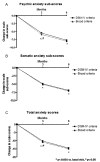Broadening of Generalized Anxiety Disorders Definition Does not Affect the Response to Psychiatric Care: Findings from the Observational ADAN Study
- PMID: 23173012
- PMCID: PMC3503236
- DOI: 10.2174/1745017901208010158
Broadening of Generalized Anxiety Disorders Definition Does not Affect the Response to Psychiatric Care: Findings from the Observational ADAN Study
Abstract
Objective: To elucidate the consequences of broadening DSM-IV criteria for generalized anxiety disorder (GAD), we examined prospectively the evolution of GAD symptoms in two groups of patients; one group diagnosed according to DSM-IV criteria and the other, according to broader criteria.
Method: Multicentre, prospective and observational study conducted on outpatient psychiatric clinics. Patients were selected from October 2007 to January 2009 and diagnosed with GAD according to DSM-IV criteria (DSM-IV group) or broader criteria. Broader criteria were considered 1-month of excessive or non-excessive worry and only 2 of the associated symptoms listed on DSM-IV for GAD diagnosis. Socio-demographic data, medical history and functional outcome measures were collected three times during a 6-month period.
Results: 3,549 patients were systematically recruited; 1,815 patients in DSM-IV group (DG) and 1,264 in broad group (BG); 453 patients did not fulfil inclusion criteria and were excluded. Most patients (87.9% in DG, 82.0% in BG) were currently following pharmacological therapies (mainly benzodiazepines) to manage their anxiety symptoms. The changes observed during the study were: 49.0% and 58.0%, respectively of patients without anxiety symptoms as per HAM-A scale at the 6 month visit (p=0.261) and 59.7% and 67.7%, respectively (p=0.103) of responder rates (> 50% reduction of baseline scoring).
Conclusion: Broadening of GAD criteria does not seem to affect psychiatric care results in subjects with GAD, is able to identify the core symptoms of the disease according to the DSM-IV criteria and could lead to an earlier diagnosis.
Keywords: Diagnostic and Statistical Manual of Mental Disorders; Generalized anxiety disorder; Hamilton Anxiety Rating Scale; Self-reported quality of life..
Figures





Similar articles
-
Overview and clinical presentation of generalized anxiety disorder.Psychiatr Clin North Am. 2001 Mar;24(1):1-17. doi: 10.1016/s0193-953x(05)70203-3. Psychiatr Clin North Am. 2001. PMID: 11225502 Review.
-
The 1-month prevalence of generalized anxiety disorder according to DSM-IV, DSM-V, and ICD-10 among nondemented 75-year-olds in Gothenburg, Sweden.Am J Geriatr Psychiatry. 2012 Nov;20(11):963-72. doi: 10.1097/JGP.0b013e318252e749. Am J Geriatr Psychiatry. 2012. PMID: 22549369
-
Efficacy of venlafaxine extended-release capsules in nondepressed outpatients with generalized anxiety disorder: A 6-month randomized controlled trial.JAMA. 2000 Jun 21;283(23):3082-8. doi: 10.1001/jama.283.23.3082. JAMA. 2000. PMID: 10865302 Clinical Trial.
-
[Sensitivity and specificity of the worry and anxiety questionnaire (WAQ) in a sample of health-care users in the province of Quebec].Encephale. 2008 Jun;34(3):240-8. doi: 10.1016/j.encep.2007.01.008. Epub 2007 Oct 24. Encephale. 2008. PMID: 18558144 French.
-
Generalized worry disorder: a review of DSM-IV generalized anxiety disorder and options for DSM-V.Depress Anxiety. 2010 Feb;27(2):134-47. doi: 10.1002/da.20658. Depress Anxiety. 2010. PMID: 20058241 Review.
Cited by
-
Modeling the longitudinal latent effect of pregabalin on self-reported changes in sleep disturbances in outpatients with generalized anxiety disorder managed in routine clinical practice.Drug Des Devel Ther. 2015 Aug 6;9:4329-40. doi: 10.2147/DDDT.S88238. eCollection 2015. Drug Des Devel Ther. 2015. PMID: 26273194 Free PMC article.
-
Long-Term Pharmacological Treatments of Anxiety Disorders: An Updated Systematic Review.Curr Psychiatry Rep. 2016 Mar;18(3):23. doi: 10.1007/s11920-016-0668-3. Curr Psychiatry Rep. 2016. PMID: 26830881
-
Clinical and economic outcomes of adjunctive therapy with pregabalin or usual care in generalized anxiety disorder patients with partial response to selective serotonin reuptake inhibitors.Ann Gen Psychiatry. 2015 Jan 22;14(1):2. doi: 10.1186/s12991-014-0040-0. eCollection 2015. Ann Gen Psychiatry. 2015. PMID: 25632294 Free PMC article.
-
Pregabalin: a review of its use in adults with generalized anxiety disorder.CNS Drugs. 2014 Sep;28(9):835-54. doi: 10.1007/s40263-014-0192-0. CNS Drugs. 2014. PMID: 25149863 Review.
-
Pregabalin versus SSRIs and SNRIs in benzodiazepine-refractory outpatients with generalized anxiety disorder: a post hoc cost-effectiveness analysis in usual medical practice in Spain.Clinicoecon Outcomes Res. 2012;4:157-68. doi: 10.2147/CEOR.S31102. Epub 2012 Jun 13. Clinicoecon Outcomes Res. 2012. PMID: 22745564 Free PMC article.
References
-
- American Psychiatric Association. Diagnostic and statistical manual of mental disorders. Washington DC: DSM-IV TR; 2000.
-
- Alonso J, Angermeyer MC, Bernert S, et al. Prevalence of mental disorders in Europe: results from the European Study of the Epidemiology of Mental Disorders (ESEMeD) project. Acta Psychiatr Scand Suppl. 2004;420:21–7. - PubMed
-
- Kessler RC, Berglund P, Demler O, Jin R, Merikangas KR, Walters EE. Lifetime prevalence and age-of-onset distributions of DSM-IV disorders in the National Comorbidity Survey Replication. Arch Gen Psychiatry. 2005;62:593–602. - PubMed
-
- Stein DJ. Comorbidity in generalized anxiety disorder: impact and implications. J Clin Psychiatry discussion 35-26. 2001;62(Suppl 11 ):29–34. - PubMed
-
- Caballero L, Bobes J, Vilardaga I, Rejas J. [Clinical prevalence and reason for visit of patients with generalized anxiety disorder seen in the psychiatry out-patient clinics in Spain. Results of the LIGANDO study]. Actas Esp Psiquiatr. 2009;37:17–20. - PubMed
LinkOut - more resources
Full Text Sources
